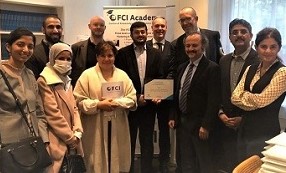Blog
Innovation and Technology, Key for Supply Chain Finance Transformation
Nov 30, 2020

A webinar summary.
While the supply chain finance sector is rising steadily, there is still a large unmet need in global trade finance, which has an estimated financing gap of $1.9 trillion annually around the world according to the International Centre for Trade and Sustainable. Nevertheless, with the availability of trade and transaction data, there is an opportunity for banks and financial institutions to gain a larger share of the supply chain finance market and help SMEs access the credit they need for their working capital needs. The SME Finance Forum hosted a webinar last month to understand how supply chain finance has been transformed due to technology. Fernando Lardiés (Banco Santander), Pamela Mar (Fung Group) and Reynaldo Rodriguez (Banco Davivienda) joined the panel to share the best practices that have been adopted by leading financial institutions for supply chain finance and how innovation and technology have become critical for the success of supply chain finance programs. Travis Mitro (SAP Ariba) also took part in the discussion. The webinar was moderated by Matthew Gamser (SME Finance Forum).
Pamela Mar of Hong Kong-based Fung Group discussed their experience of working on the ground with suppliers, particularly during the early days of the supply and demand shocks caused by COVID-19. Financial precarity within the supply chain network became evident as SMEs lack reserve money, have thin margins and are often dependent on buyer-linked financing. Although enterprises have adjusted to this “new normal” it is still hard for SMEs to get access to capital. To address the problem, Fung Group’s Chairman Victor Fung, in collaboration with the International Chamber of Commerce, has launched a platform called Advisory Group on Trade Finance (ATF). The ATF advocates for trade as a driver of global growth, brings attention to the problem of trade finance and directly engages with policy makers and multilateral organizations to encourage governments to free up capital in the banking system and promote the digitization of trade and finance. The ATF platform will be used to power the COVID-19 recovery process and help open the dialog regarding the idea of rebuilding, sustainability and inclusivity.
Fernando Lardiés of Banco Santander expands the discussion by taking people back to the basics of lending and the process of delivery in SME financing. According to him, the more pressing problem is with assessing the risk elements in order to change SME finance and trade finance. When gaps of information are present in the system, financing through trade or supply chain is the solution for SMEs because someone more significant in the chain will be able to share information regarding their credibility. However, in the absence of a large anchor, one needs to have tools to generate information for the small and medium businesses who only have an invoice, purchase order and no other document. To address the risk and legal environment, Banco Santander has developed new technologies to get additional information for assessing the risk profile and the commercial relationships the owners claim. As the Head of Global Trade Services, Fernando has focused on transitioning trade delivery to a more digitized process with an adjacent component that allows assessing risk better in the matters of trade financing. According to him, industry-wide efforts regarding information exchange to mitigate risk levels are already in swing as absence of information has been a significant barrier for clients in a regulated banking environment.
Reynaldo Rodriguez of Banco Davivienda highlights the issues being experienced by their customers during the times of COVID 19. Banco Davivienda is a Columbian bank which has 135 years of history in El Salvador. They have found that a formalization complexity exists, which creates many barriers for SMEs to access finance. The overwhelming process of documentation deters SMEs from approaching financial institutions. However, familiarity with the documentation process has eased the process on the customer side. They have also found that SME’s cash flow does not match the flows of the loan they receive. To address these issues, they created a product called Credinegocio, which is the first 100% digital product in El Salvador for SMEs. The product allows owner or administrator of SMEs to just login, request for a loan and receive it. The whole process takes about three clicks in total on the platform. Moreover, the bank has standardized one reference date to pay the loans, which makes the system less complicated and easier for the customer to remember to pay back dues. Another initiative on the supply chain side is the Take Suppliers, which helps Banco Davivienda work with the entire supply chain and provide them with special benefits in return. For the future, Banco Davivienda intends to help expand SMEs reach in their international trade transactions.
Travis Mitro of SAP Ariba talks about the importance of technology and ways of doing financing. Primarily, he stresses the importance of using alternative ways of financing for countries that lack the frequent use of existing financial infrastructure like traditional bank accounts and rely significantly on paper transactions. He also mentions SAP’s Innovation’s Lab and their work exploring ways to incorporate IoT and blockchain into the process for big commodity chains. Lastly, he talks about the benefit of using mobile technology to enhance financial opportunities in the supply chain because it lowers fraud and improve transparency.
The webinar addressed the following topics: a greater need for connectivity between several stakeholders, better-informed risk management for small and medium businesses, coping with compliance issues in building supply chain portfolios, and the potential of IoT and black chain in innovating financial services across the globe.











